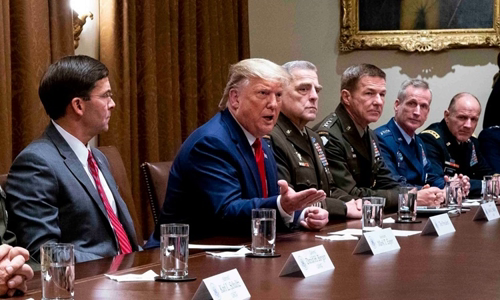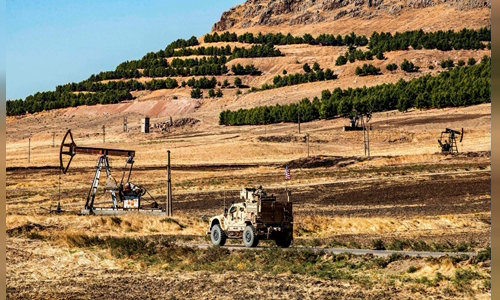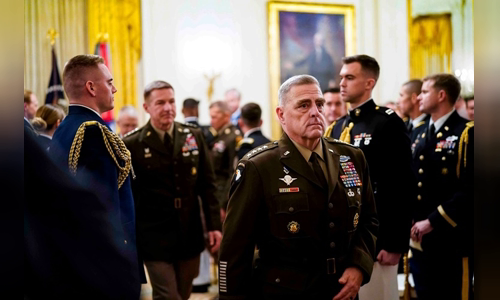A few days after Trump suddenly decided to withdraw all troops from Syria, General Mark A. Milley found a way to turn the situation around.
The decision to withdraw the troops was made so suddenly by President Donald Trump that all the generals at the Pentagon could hardly stand up. Many discouraging opinions have been given, from the protection of the Kurdish allies to the eradication of the self-proclaimed Islamic State (IS) rebels, which have not moved Trump.

President Trump at a meeting with military leaders in the White House last month Photo: NYTimes
But General Milley, chairman of the Joint Chiefs of Staff, understands that Trump is a businessman and has always been concerned about the oil fields in Syria. Therefore, he proposed to Trump that American special forces, along with Kurdish fighters, would protect these oil fields from the risk of falling into IS or Russia and Iran hands.
This approach has worked effectively, helping the Pentagon catch up with Trump's "pinwheel" dance in Syria. Following an order to withdraw 1,000 troops from Syria's northern border, a decision was made to keep 800 US troops at oil fields in eastern Syria.
"We are protecting the oil," Trump told reporters on Tuesday before meeting with Turkish President Recep Tayyip Erdogan at the White House. "We left the military behind because of the oil fields."
"I believe Milley was the one who persuaded the President to change the decision regarding Syria," said Jack Keane, a former US Army deputy commander. He spoke several times with Trump and Milley last month during a period when Washington was reeling from the White House's Syrian policy.
For nearly three years during Trump's term, the Pentagon continued to learn to keep pace with a President whose decisions could be changed in just a few hours. Defense Department officials must "tolerate information" in a difficult way: Through Trump's tweets.
But they still loved him. They are pleased with the annual increase in budget that Trump has set for them, from $ 585 billion in 2016 to $ 716 billion this year.
They are glad he ended what they call micro-management since President Barack Obama. Trump also gives military commanders on the battlefield more autonomy whenever they want to launch attacks. Among the military ranks, he is still very popular, observers evaluate.
When Trump came to power, he gave more power to the Pentagon and military commanders. He allowed the Department of Defense to speed up the decision-making process so that the military could act faster in raids, airstrikes, airstrikes, or support allies in Iraq, Syria or anywhere.
But freedom also comes with greater responsibility. If the problem gets worse, the Pentagon is the first party to be blamed by Trump. After a surprise raid in Yemen in January 2017 that killed William "Ryan" Owens, a US Navy SEAL member, Trump blamed the military. This was in contrast to previous presidents, when they always took responsibility for the military operations they ordered.
"Army generals, who are highly respected, they explain what they want to do. And then they lose Ryan," Trump told Fox News after the raid.

An oil field in northeastern Syria Photo: AFP
During the war in Syria, the Pentagon gave Trump a surprise gift that made him extremely excited: Operation raid to destroy ISIS leader Abu Bakr al-Baghdadi on October 26. The next day, Trump mentioned General Milley four times during a press conference announcing the 48-minute raid, thanking him for his "unbelievable" success on the Syrian battlefield.
Even so, military commanders have learned to carefully consider their comments, alerting their voices to possible inference to implicit criticism of the President.
At a press conference, General Kenneth F. McKenzie Jr., commander of the US Central Command, refused to reiterate Trump's words that the IS leader had "whimpered" before activating the suicide bomb belt at the site. shelter because the task force chased to death. However, McKenzie supported President Trump when he described Baghdadi as a coward.
"He got into a hole with two kids, blowing himself up," McKenzie said. "You can draw on yourself what kind of person he is based on that action."
Ministry of Defense officials also ensure that they frequently talk about the importance of having to ask the allies of the North Atlantic Treaty Organization (NATO) in Europe to "pay a proportionate amount", as expected. that President Trump has long raised.
According to experts, the biggest bottleneck in the relationship between Trump and the military lies in Syrian policy.
The problem began in December last year, when Trump first sought to bring back 2,000 US troops in Syria, deciding to make defense minister James Mattis resign in protest.
In the storm that followed, Republicans, Democrats and Trump's advisers said he would withdraw from the battle before IS were completely defeated. However, Trump rethought and agreed to keep 1,000 soldiers in Syria.
Last time, the Pentagon mostly asked them to operate almost secretly to avoid drawing attention to the fact that the Department of Defense persuaded President Trump to withdraw the original order.
In early October, after a phone call with the Turkish president, Trump signaled that he would withdraw the rest of the troops, a move criticized for paving the way for Ankara's military operation. into the Kurds in Syria, the closest ally to the US on the battlefield against ISIS. But the US military does not want to leave the Kurds.

General Miller at the White House in October Photo: NYTimes
"The idea of abandoning people who have sacrificed so much is really offensive," said Mac Thornberry, a member of the House of Armed Services Committee. "The military wants to obey orders from political leaders, but it does not want to betray the sacrifices of the teammates. This puts the army in a difficult position, at least in their hearts."
General Milley, along with Secretary Esper, quickly sought to persuade President Trump to believe that the US military still had work to do in Syria. The Central Command, the unit in charge of operations in the Middle East, drafted two plans.
A proposal to maintain a modest US force to help control about 10% of the border areas of Iraq and Syria. The other option is that the military will try to control more than 50% of the area that the US and Kurdish militants hold.
But after Trump told General Milley that he wanted to keep the oil field, the Pentagon immediately drafted a new plan around using U.S. forces and Kurdish allies to protect oil from falling into IS hands. From Brussels, Belgium, where he was meeting with NATO, Minister Esper exchanged over the phone with General Milley to finalize the details of the new plan.
For his part, General Milley was advised by his friends that he should not openly show his attitude against President Trump's decisions and strategies. Through countless conversations, Milley learned how to give clear opinions but still made the President feel like he owned the conversation.
By the end of October, Trump agreed with the Pentagon plan. While watching the match between Washington Nationals and Houston Astros on October 28 alongside Republican MPs and advisers, the US President suddenly spoke of Syria.
Trump mentioned that he was revising plans related to Syria, constantly telling lawmakers that the US military would still remain. Why? Because the US "has to hold the oil".
According to some senior military and defense ministry officials, in many cases, the simple problem lies in how President Trump feels intrigued by the proposals.
"The Pentagon has found a way to exploit Trump's preconceptions," said Derek Chollet, a former assistant secretary of defense under the Obama administration. "Don't talk about saving the Kurds, let's talk about saving oil fields."



 CoraMonteflorPacure
CoraMonteflorPacure







